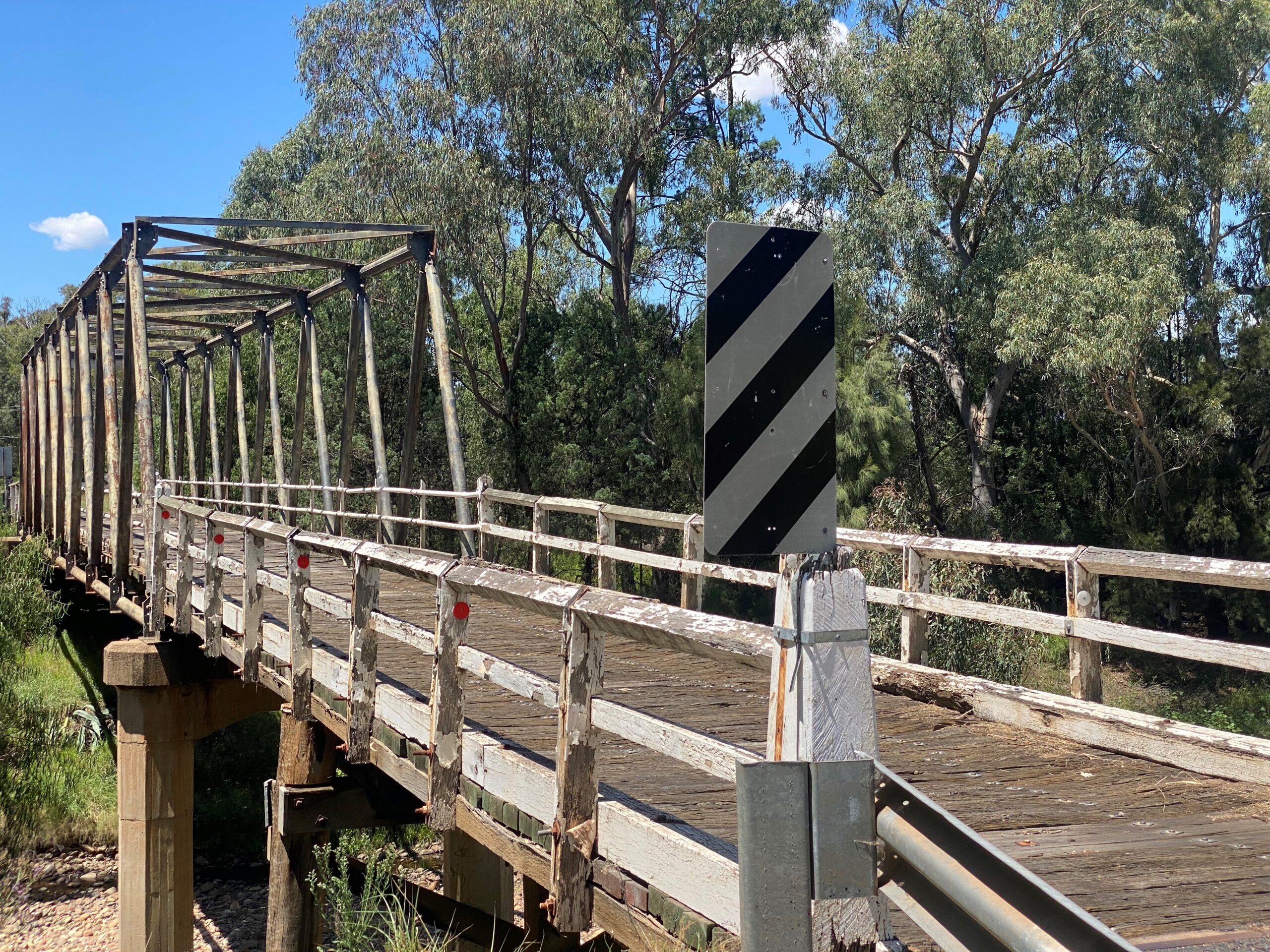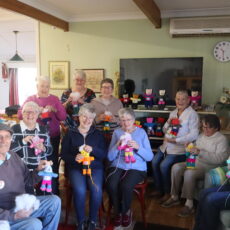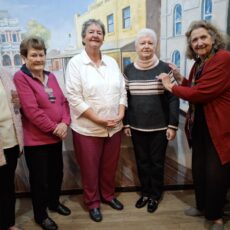By Fay Barrett
The picturesque steel and timber Bailey Bridge spanning Bullawa Creek on the Eulah Creek Road for just over seventy years is soon to be replaced.
She has served us faithfully, standing tall, reigning through years of drought and over roaring, raging flood waters, carrying her charges safely across, but has now well and truly passed her use by date.
A new bridge will be built this year, 2023, weather permitting.
As early as 1934, farmers of Eulah Creek, at their Agricultural Bureau meeting, voted to form a deputation of residents to meet with the then Namoi Shire Council regarding the urgent need for a bridge to allow them to cross Bullawa Creek and then onwards to Narrabri.
The only crossing available at that time was through the creek bed.
When heavy rain flooded, or partially flooded the creek, this often left the residents stranded.
The Eulah Creek farmers were very community minded, as people often were back then, caring for one another through the good times and the inevitable bad times. Regular games of cricket, vigaro and tennis were played at the recreational grounds, where the local residents built a cement cricket pitch, a vigaro field and a tennis court and in later years Beulah Park Hall was built for the enjoyment of all.
Dances were held on both Eulah and Bullawa Creeks, originally in local grain sheds, cleaned up and swept out for the occasion, then in the hall when it was built.
They supplied their own music, talented souls, playing the fiddle, piano and the accordion. These gatherings were enjoyed by the locals and townsfolk alike.
A church was built in 1924 on the edge of Bullawa Creek on the western side, residents of Eulah Creek lived on the eastern side, so, needed to make the crossing for Sunday services, weddings, christenings and funerals. All manner of horse traffic would be seen at the church, tethered along the fence line.
Prior to the building of the church, an Anglican minister, or Catholic priest made his way out from Narrabri occasionally, on horseback, and services were held in local farmhouses.
Families dug the graves for their loved ones on their properties until 1900, when a local cemetery, allotted by the Department of Lands was founded alongside the recreational grounds.
The little, one room Eulah Creek Public School and teacher’s residence sat on the edge of these grounds, where the teacher did his best to cram an understanding of the ‘three R’s’ into the heads of farm kids who were born with an inbuilt knowledge of the variables of Mother Nature, animal husbandry and plant propagation.
Settlers living on both creeks, Eulah and Bullawa, grew a veritable cornucopia of produce. There were the drought years, but also the abundant years. The water table was high, wells were dug by hand and in both creeks, springs abounded, and water flowed.
The rich creek flats and the fertile valley soils produced an astonishing array of grain crops, fruit and vegetables, horses, bullocks, fat lambs, dairy and beef cattle, pigs and poultry.
The beautiful gentle giants, the draft horses, were used to prepare the soil, to plant and gather the crops, harnessed up in teams, using their great strength to pull their loads, and on good years hay sheds were filled to the rafters.
They all lived a self-sufficient lifestyle, many years before “self-sufficiency” became a fancy catch phrase, supplying their families and supplementing their income by taking their produce into Narrabri to the farmers’ markets which were held every Tuesday and Friday.
They grew pumpkins, gramma, Hubbard squash, watermelon, rock melon, grapes, citrus fruit, juicy peaches, apricots, plums, lettuce and tomato, cucumber, fresh beans, sweet corn, bunches of beetroot, carrot and spinach, cabbage and turnip just to name a few, fresh farm eggs and turkey chicks were raised to sell, and a local beekeeper produced delicious honey.
Fresh produce is very perishable, so a reliable road to town was sorely needed. A reliable creek crossing was also crucial when medical emergencies arose – farm work can be fraught with danger, especially when large animals are involved.
In the 1930s and 40s, motor vehicles were slowly becoming available, but many families relied on the trusty horse and sulky to make their trip into the township, especially during the war years, (1939- 1945), saddle horses and horse and dray were also a common form of transport.
The early motor vehicles were a temperamental lot, to say the least. Springs were open to improvement, bouncing along gravel roads, and should you drive through the smallest puddle, water invariably splashed onto the wires and the motor would come to a spluttering, shuddering halt. The driver then climbed out, lifted the bonnet, which by the way, often folded up sideways over the motor, to wipe the wires with a rag. Nothing more could be done, but sit and wait till the offending damp wires dried sufficiently to allow the motor to kick over again to continue the journey. This was a regular occurrence, simply to cross Phills gully. The creek crossing was still to come, at least two miles ahead.
The only road to town was, of course, in those days, basically a gravel track, but the main problem was the crossing at Bullawa Creek, known to the locals as ‘the eight mile,’ being approximately eight miles from Narrabri.
Residents made numerous pleas to Namoi Shire Council over the intervening years. The shire council was at that time responsible for rural areas, and the Municipal Council cared for the town.
The crossing at Bullawa Creek was in very poor condition, flooding caused great havoc, a storm in the mountains was sufficient to bring the waters down, blocking the road.
It had a gravel bottom which shifted often, resulting in a very dangerous situation. The council acknowledged the justice of the residents’ claim, but pointed out their difficulty was, as usual, financial.
They suggested an application be made for a grant, and the importance of the produce of the area to be stressed when the application is made. Council would make an application for 50 per cent of the cost of a new bridge.
Finally! In 1948, survey work began for the proposed bridge over Bullawa Creek, on Eulah Creek Road. The site selected is several chains downstream from the present crossing.
To the relief of all concerned, a Bailey Bridge was chosen and on May 28, 1951, tenders were invited for the construction of a bridge, comprising one, 112 foot steel military truss span, and three timber beam approach spans, over Bullawa Creek on Eulah Creek Road, eight miles from Narrabri.
In the years immediately following World War II, huge amounts of war surplus Bailey bridging was made available worldwide.
A Bailey Bridge is a portable, pre-fabricated truss bridge, developed in 1940- 41, by the British for military use during the Second World War.
Its success was due to the simplicity of the fabrication and assembly of its modular components.
It has the advantages of requiring no special tools or heavy equipment to assemble.
Reported in The North Western Courier, July 1951.
“A number of settlers from Eulah Creek area have offered to make a substantial cash contribution towards the cost of erection of a proposed new bridge across Bullawa Creek.
A deputation of three residents at last Shire meeting stated the majority preferred to make a cash contribution, rather than pay a special rate over twenty years.
The amount offered was two thousand, one hundred and fifty pounds, leaving four hundred and seventy-five pounds, to be contributed by four other residents over twenty years.
The council expressed the hope that the four residents who favored the rate over twenty years would change their views and make a cash contribution, as the minister would be likely to query a special rate on only four holdings.
The shire president told the deputation it was probable no call would be made for funds for some time, in fact, until work was commencing on the bridge.”
In 1952, pile driving for abutment on the site was completed. Excavation for the foundation of the main piers was now commencing! Finally, a bridge was to become a reality.
I’m sure there will be many residents of ‘the creek’ today who look forward to, and be very pleased to see a new bridge, spanning the creek, but for those of us who have known her our whole lives, there will be sadness, she has served us well.
To order photos from this page click here










